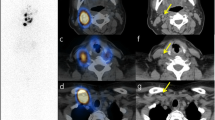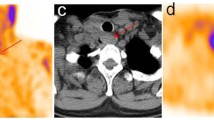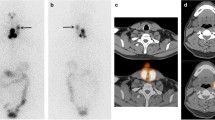Abstract
Objective
This study aims to determine whether a 131I double-phase whole body scan (WBS) and SPECT-CT images have added value over a single-phase WBS image in identifying benign and malignant lesions in patients with well-differentiated thyroid cancer (DTC) at their first radioactive iodine (RAI) treatment.
Methods
This study included 42 DTC patients who underwent their first radioablation. Post-therapeutic WBS images were acquired after 3 days (early phase) and 7 days (delayed phase). Following early-phase WBS, SPECT-CT images were obtained. The images were reviewed independently of the clinical data by 2 board-certified observers with a 6-point scoring system (benign to malignant −3 to +3).
Results
The double-phase WBS and SPECT-CT images showed 115 radioiodine-avid localizations (81 benign and 34 malignant accumulations). Confidence levels of benign accumulations were significantly higher with SPECT-CT (average score −2.40 ± 1.06) compared to those of the early-phase WBS (average score −1.39 ± 1.88) (p < 0.0001) and delayed-phase WBS images (average score −1.49 ± 1.19) (p < 0.0001). When the analysis was restricted to accumulations with a low confidence score in the early-phase WBS image, the confidence level of the delayed-phase WBS was higher compared to that of the early-phase WBS images (p = 0.0012). The confidence levels of malignant accumulations were significantly higher with SPECT-CT images (average score 2.37 ± 0.96) compared to the early-phase WBS (average score 1.44 ± 1.21) (p < 0.0001) and the delayed-phase WBS images (average score 1.50 ± 1.13) (p < 0.0001).
Conclusion
Post-therapeutic SPECT-CT image was superior to the early-phase WBS image in enhancing the confidence level and accurately localizing the lesions. The delayed-phase WBS image contributed to the accurate diagnosis of benign lesions with a low confidence level in the early-phase WBS image.






Similar content being viewed by others
References
Cooper DS, Doherty GM, Haugen BR, Kloos RT, Lee SL, Mandel SJ, et al. Revised American Thyroid Association management guidelines for patients with thyroid nodules and differentiated thyroid cancer. Thyroid. 2009;19:1167–214.
Sherman SI. Thyroid carcinoma. Lancet. 2003;361:501–11.
Hay ID, McConahey WM, Goellner JR. Managing patients with papillary thyroid carcinoma: insights gained from the Mayo Clinic’s experience of treating 2,512 consecutive patients during 1940 through 2000. Trans Am Clin Climatol Assoc. 2002;113:241–60.
McGriff NJ, Csako G, Gourgiotis L, Lori CG, Pucino F, Sarlis NJ. Effects of thyroid hormone suppression therapy on adverse clinical outcomes in thyroid cancer. Ann Med. 2002;34:554–64.
Beasley NJ, Lee J, Eski S, Walfish P, Witterick I, Freeman JL. Impact of nodal metastases on prognosis in patients with well-differentiated thyroid cancer. Arch Otolaryngol Head Neck Surg. 2002;128:825–8.
Pelizzo MR, Boschin IM, Toniato A, Piotto A, Pagetta C, Gross MD, et al. Papillary thyroid carcinoma: 35-year outcome and prognostic factors in 1858 patients. Clin Nucl Med. 2007;32:440–4.
Verburg FA, de Keizer B, Lam MG, de Klerk JM, Lips CJ, Borel-Rinkes IH, et al. Persistent disease in patients with papillary thyroid carcinoma and lymph node metastases after surgery and iodine-131 ablation. World J Surg. 2007;31:2309–14.
Fatourechi V, Hay ID, Mullan BP, Wiseman GA, Eghbali-Fatourechi GZ, Thorson LM, et al. Are posttherapy radioiodine scans informative and do they influence subsequent therapy of patients with differentiated thyroid cancer? Thyroid. 2000;10:573–7.
Sherman SI, Tielens ET, Sostre S, Wharam MD Jr, Ladenson PW. Clinical utility of posttreatment radioiodine scans in the management of patients with thyroid carcinoma. J Clin Endocrinol Metab. 1994;78:629–34.
Souza Rosario PW, Barroso AL, Rezende LL, Padrao EL, Fagundes TA, Penna GC, et al. Post I-131 therapy scanning in patients with thyroid carcinoma metastases: an unnecessary cost or a relevant contribution? Clin Nucl Med. 2004;29:795–8.
Lubin E, Mechlis-Frish S, Zatz S, Shimoni A, Segal K, Avraham A, et al. Serum thyroglobulin and iodine-131 whole-body scan in the diagnosis and assessment of treatment for metastatic differentiated thyroid carcinoma. J Nucl Med. 1994;35:257–62.
Tharp K, Israel O, Hausmann J, Bettman L, Martin WH, Daitzchman M, et al. Impact of 131I-SPECT/CT images obtained with an integrated system in the follow-up of patients with thyroid carcinoma. Eur J Nucl Med Mol Imaging. 2004;31:1435–42.
Chen L, Luo Q, Shen Y, Yu Y, Yuan Z, Lu H, et al. Incremental value of 131I SPECT/CT in the management of patients with differentiated thyroid carcinoma. J Nucl Med. 2008;49:1952–7.
Schmidt D, Szikszai A, Linke R, Bautz W, Kuwert T. Impact of 131I SPECT/spiral CT on nodal staging of differentiated thyroid carcinoma at the first radioablation. J Nucl Med. 2009;50:18–23.
Spanu A, Solinas ME, Chessa F, Sanna D, Nuvoli S, Madeddu G. 131I SPECT/CT in the follow-up of differentiated thyroid carcinoma: incremental value versus planar imaging. J Nucl Med. 2009;50:184–90.
Grewal RK, Tuttle RM, Fox J, Borkar S, Chou JF, Gonen M, et al. The effect of posttherapy 131I SPECT/CT on risk classification and management of patients with differentiated thyroid cancer. J Nucl Med. 2010;51:1361–7.
Dietlein M, Moka D, Scheidhauer K, Schmidt M, Theissen P, Voth E, et al. Follow-up of differentiated thyroid cancer: comparison of multiple diagnostic tests. Nucl Med Commun. 2000;21:991–1000.
Lind P. 131I whole body scintigraphy in thyroid cancer patients. Q J Nucl Med. 1999;43:188–94.
Hung BT, Huang SH, Huang YE, Wang PW. Appropriate time for post-therapeutic I-131 whole body scan. Clin Nucl Med. 2009;34:339–42.
Hanscheid H, Lassmann M, Luster M, Thomas SR, Pacini F, Ceccarelli C, et al. Iodine biokinetics and dosimetry in radioiodine therapy of thyroid cancer: procedures and results of a prospective international controlled study of ablation after rhTSH or hormone withdrawal. J Nucl Med. 2006;47:648–54.
Author information
Authors and Affiliations
Corresponding author
Rights and permissions
About this article
Cite this article
Wakabayashi, H., Nakajima, K., Fukuoka, M. et al. Double-phase 131I whole body scan and 131I SPECT-CT images in patients with differentiated thyroid cancer: their effectiveness for accurate identification. Ann Nucl Med 25, 609–615 (2011). https://doi.org/10.1007/s12149-011-0513-z
Received:
Accepted:
Published:
Issue Date:
DOI: https://doi.org/10.1007/s12149-011-0513-z




